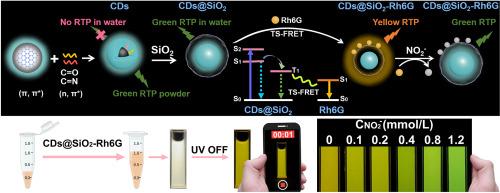Design and application of ratiometric room temperature phosphorescent probes based on triplet-singlet Fӧrster resonance energy transfer mechanism between silica-coated phosphorescent carbon dots and rhodamine 6G
IF 11.6
2区 材料科学
Q1 CHEMISTRY, PHYSICAL
引用次数: 0
Abstract
In this paper, we successfully designed and constructed a ratiometric room temperature phosphorescent probe (CDs@SiO2–Rh6G) that can realize highly sensitive detection of nitrite in urine under the interference of ascorbic acid (AA) based on the triplet-to-singlet Fӧrster resonance energy transfer mechanism between silica-coated phosphorescent carbon dots and rhodamine 6G. This unique energy transfer mechanism is discussed in detail, and the interference of various factors on nitrite detection is systematically investigated. With the successful masking of AA by 4-hydroxy-2,2,6,6-tetramethylpiperidinooxy (4-OH-TEMPO), CDs@SiO2–Rh6G could accurately detect NO2− with a limit of detection (LOD) as low as 0.242 μmol/L, which is much lower than that of the commercially available urinary nitrite test paper. The probe was tested on real urine samples—human, dog, and cat urine—and the results were highly consistent with those obtained by ion chromatography, with spike recoveries ranging from 96.5 % to 105.3 %. Since the green and yellow luminescence of the probe is visible to the naked eye, a visual analysis method based on the RGB values of smartphones was developed. This study presents a new strategy for constructing ratiometric room temperature phosphorescent probes based on a unique TS-FRET mechanism. Meanwhile, this research not only overcomes the quantitative limitations of current test strip detection methods but also lays the foundation for developing more sensitive and accurate clinical diagnostic tools for urinary tract infections.

基于三重单线态Fӧrster硅包覆磷光碳点与罗丹明6G共振能量传递机制的比例室温磷光探针设计与应用
本文基于硅包被磷光碳点与罗丹明6G之间的三重态到单重态Fӧrster共振能量传递机制,成功设计并构建了一种室温比例磷光探针(CDs@SiO2 -Rh6G),可在抗坏血酸(AA)干扰下实现对尿液中亚硝酸盐的高灵敏度检测。详细讨论了这种独特的能量传递机理,系统研究了各种因素对亚硝酸盐检测的干扰。CDs@SiO2 -Rh6G通过4-羟基-2,2,6,6-四甲基哌替啶(4-OH-TEMPO)成功屏蔽AA,可准确检测NO2−,检出限(LOD)低至0.242 μmol/L,远低于市售尿亚硝酸盐试纸。该探针在真实尿液样品(人、狗和猫尿液)上进行了测试,结果与离子色谱法的结果高度一致,峰回收率在96.5% ~ 105.3%之间。由于探针的绿色和黄色发光是肉眼可见的,因此开发了基于智能手机RGB值的视觉分析方法。本研究提出了一种基于独特的TS-FRET机制构建比例室温磷光探针的新策略。同时,本研究不仅克服了现有试纸检测方法的定量局限性,也为开发更加灵敏、准确的尿路感染临床诊断工具奠定了基础。
本文章由计算机程序翻译,如有差异,请以英文原文为准。
求助全文
约1分钟内获得全文
求助全文
来源期刊

Carbon
工程技术-材料科学:综合
CiteScore
20.80
自引率
7.30%
发文量
0
审稿时长
23 days
期刊介绍:
The journal Carbon is an international multidisciplinary forum for communicating scientific advances in the field of carbon materials. It reports new findings related to the formation, structure, properties, behaviors, and technological applications of carbons. Carbons are a broad class of ordered or disordered solid phases composed primarily of elemental carbon, including but not limited to carbon black, carbon fibers and filaments, carbon nanotubes, diamond and diamond-like carbon, fullerenes, glassy carbon, graphite, graphene, graphene-oxide, porous carbons, pyrolytic carbon, and other sp2 and non-sp2 hybridized carbon systems. Carbon is the companion title to the open access journal Carbon Trends. Relevant application areas for carbon materials include biology and medicine, catalysis, electronic, optoelectronic, spintronic, high-frequency, and photonic devices, energy storage and conversion systems, environmental applications and water treatment, smart materials and systems, and structural and thermal applications.
 求助内容:
求助内容: 应助结果提醒方式:
应助结果提醒方式:


